IAS 34, Interim Financial Reporting, established new requirements for interim reporting, while not making the reporting of interim results mandatory. While the draft preceding this standard’s promulgation essentially endorsed a discrete approach (applying measurement principles to each interim period on a stand-alone basis), the final standard represents a judicious mix of integral and discrete viewpoints. IAS 34 adopts an integral viewpoint with regard to income tax expense, as indeed was necessitated by the fact that taxing authorities almost universally apply their requirements to a full year, taken as a whole, with no attempt at interim measurement of results of operations.
In this post, guidance is offered to assist in applying the principles of income tax accounting set forth in IFRS [IAS 12 and 34] to interim periods when the enterprise elects (or is mandated) to report on such as basis. The general consensus is that the appropriate perspective for interim period reporting is to view the interim period as an integral part of the year rather than as a discrete period.Caution: This guidance should be understood as being illustrative rather than authoritative. Care should be taken in particular regarding areas of financial reporting which are guided by recently issued or revised international accounting standards (such as that for discontinuing operations).
For purposes of computing income tax provisions, this objective is usually achieved by projecting income for the full annual period, computing the tax thereon, and applying the effective rate to the interim period income or loss, with quarterly (or monthly) revisions to the expected annual results and the tax effects thereof, as necessary.
Notwithstanding this general principle, however, there are certain complexities that arise only in the context of interim financial reporting. Included in this group of issues are:
- Recognizing the tax benefits of losses based on expected earnings of later interim or annual periods.
- Reporting the benefits of net operating loss carryforwards in interim periods
- Reporting the effects of tax law changes in interim periods.
Other matters requiring interpretation include the classification of deferred taxes on interim statements of financial position and the allocation of interim period tax provisions between current and deferred expense.
Example Of Interim Period Accounting For Income Taxes
Lie Dharma, Inc. estimates that accounting profit for the full fiscal year ending June 30, 2008, will be $400,000. The company expects the annual premium on an officer’s life insurance policy to be $12,000, and dividend income (from a less than 20% ownership interest) is expected to be $100,000. Under pertinent tax rules, premiums paid on officer’s life insurance is not an expense.
Furthermore, there is a dividends received deduction of 70% for intercorporate investments of under 20%. Deferred organization costs are being amortized for financial reporting purposes (having been assessed as having limited life), but cannot be deducted for tax purposes in the company’s jurisdiction. Organization cost amortization is $30,000 per year.
The company recognized income of $75,000 in the first quarter of the year. The deferred tax liability arises solely in connection with depreciation temporary differences; these differences totaled $150,000 at the beginning of the year and are projected to equal $280,000 at year-end.
The effective rate expected to apply to the reversal at both year beginning and year-end is 34%. The change in the taxable temporary difference during the current interim period is $30,000.
Lie Dharma must first calculate its estimated effective income tax rate for the year. This rate is computed using all the tax planning alternatives available to the company (e.g., tax credits, foreign rates, capital gains rates, etc.). See below:

The deferred tax provision for the interim period should be based on the actual change in the temporary difference (depreciation, in this example) during the interim period. In this case the depreciation temporary difference grew by $30,000 during the period, and the expected tax rate that will apply to the reversal, in future years, is the marginal rate of 34%.
Accordingly, the tax provision for the period is as follows:
Ordinary income for the interim period = $75,000
Less: Change in temporary difference = 30,000
Net ordinary income = 45,000
Applicable tax rate x 26.1%
Current tax provision = 11,755
Tax effect of temporary difference
($30,000 × 34%) = 10,200
Total provision = $21,955
Therefore, the entry necessary to record the income tax expense at the end of the first quarter is as follows:
[Debit]. Income tax expense = 21,955
[Credit]. Income taxes payable—current = 11,755
[Credit]. Deferred tax liability = 10,200
In the second quarter, Lie Dharma, Inc. revises its estimate of income for the full fiscal year. It now anticipates only $210,000 of book income, including only $75,000 of dividend income, because of dramatic changes in the national economy. Other permanent differences are still expected to total $42,000.
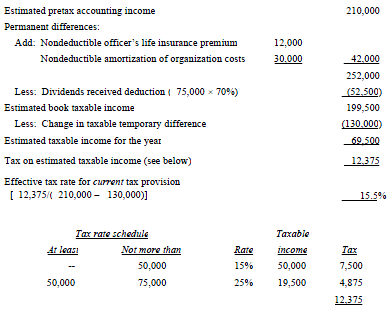
The actual earnings for the second quarter were $22,000, and the change in the temporary difference was only $10,000. The tax provision for the second quarter is computed as follows:
Ordinary income for the half year =$97,000
Less: Change in temporary difference = 40,000
Net ordinary income = 57,000
Applicable tax rate x 15.5%
Current tax provision = 8,835
Tax effect of temporary difference
($40,000 × 34%) = 13,600
Total provision = $22,435
Under the general principle that changes in estimate are reported prospectively, the results of prior quarters are not restated for changes in the estimated effective annual tax rate.
Given the provision for current and deferred income taxes that was made in the first interim period, shown above, the following entry is required to record the income taxes as of the end of the second quarter:
[Debit]. Income tax expense = 480
[Debit]. Income taxes payable—current = 2,920
[Credit]. Deferred tax liability = 3,400
The foregoing illustrates the basic problems encountered in applying the promulgated US GAAP to interim reporting. Next, let’s discuss some items requiring modifications to the approach described above.
Net Operating Losses (NOL) in Interim Periods
The tax effects of operating losses are treated no differently than any other temporary differences; if probable of being realized, the tax effects are reflected as deferred tax benefits in the period the loss is incurred. If not deemed probable, no tax effects are recognized; if the estimation of realizability changes in a later period, the deferred tax benefit is then recorded, with the offset being included in current period tax expense.
However, given the desire to treat interim periods as integral parts of the annual period of which they are a component, the accounting treatment of net operating losses raises a number of issues. These include: (1) calculation of the expected annual tax rate for purposes of interim period income tax provisions; and (2) recognition of an asset for the tax effects of a loss carryforward.
1. Carryforward from Prior Years
Loss carryforward benefits from prior years first given recognition (i.e., by recordation of a deferred tax benefit when none had been recognized in the period the loss was incurred) in interim periods are included in the ordinary tax provision.
Common practice is to compute the expected annual effective tax rate on ordinary income at each interim reporting date, and use this rate to provide income taxes on ordinary income on a cumulative basis at each interim date.
The tax effects of extraordinary items, discontinued operations, and other nonoperating categories were excluded from this computation; those tax effects are typically separately determined on a with-and-without basis, as explained later in this post.
Recognition of a previously unrecognized tax benefit should be included as a credit in the tax provision of the interim period when there is a reevaluation of the likelihood of future tax benefits being realized.
Similarly, a reduction of the deferred tax benefit resulting from a revised judgment that the benefits are not probable of being realized would cause a catch-up adjustment to be included in the current interim period’s ordinary tax provision.
In either situation, the effect is not prorated to future interim periods by means of the effective tax rate estimate. To illustrate, consider the following example.
Example Of Carryforward From Prior Years
XYZ Corporation has a previously unrecognized $50,000 net operating loss carryforward; a flat 40% tax rate for current and future periods is assumed. Income for the full year (before NOL) is projected to be $80,000; in the first quarter a pretax loss of $10,000 will be reported.
Projected annual income = $80,000
× Tax rate 40%
Projected tax liability = $32,000
Accordingly, in the statement of comprehensive income for the first fiscal quarter, the pretax operating loss of $10,000 will give rise to a tax benefit of $10,000 × 40% = $4,000.
In addition, a tax benefit of $20,000 (=$50,000 loss carryforward × 40%) is given recognition and is included in the current interim period tax provision relating to continuing operations.
Thus, total tax benefit for the first fiscal quarter will be $24,000 (= $4,000 + $20,000). If XYZ’s second quarter results in a pretax operating income of $30,000, and the expectation for the full year remains unchanged (i.e., operating income of $80,000), the second quarter tax provision is $12,000 (=$30,000 × 40%).
The tax provision for the fiscal first half-year will be a benefit of $12,000, as follows:
Cumulative pretax income through
second quarter ($30,000 – $10,000) = $ 20,000
Effective rate x 40%
Tax provision before recognition of
NOL carryforward benefit = 8,000
Benefit of NOL carryforward first-
recognized in first quarter = (20,000)
Total tax provision (benefit) = (12,000)
Note: The foregoing example assumes that during the first quarter, XYZ’s judgment changed as to the full realizability of the previously unrecognized benefit of the $50,000 loss carryforward.
Were this not the case, however, the benefit would have been recognized only as actual tax liabilities were incurred (through current period earnings) in amounts to offset the NOL benefit.
To illustrate the latter situation, assume the same facts about earnings for the first two quarters, and assume now that XYZ’s judgment about realizability of prior period NOL does not change. Tax provisions for the first quarter and first half are as follows:

Notice that recognition of a tax benefit of $4,000 in the first quarter is based on the expectation of at least a breakeven full year’s results. That is, the benefit of the first quarter’s loss was deemed probable of realization. Otherwise, no tax benefit would have been reported in the first quarter.
2. Estimated Loss For The Year
When the full year is expected to be profitable, it will be irrelevant that one or more interim periods results in a loss, and the expected effective rate for the full year should be used to record interim period tax benefits, as illustrated above. However, when the full year is expected to produce a loss, computation of the expected annual tax benefit rate must logically take into account the extent to which a deferred tax asset will be recordable at year-end.
For the first set of examples, below, assume that the realization of tax benefits related to operating loss carryforwards, are not entirely probable. That is, only a portion of the benefits will be recognized.
For each of the following examples we assume that the Putra Corporation is anticipating a loss for the fiscal year of $150,000. A deferred tax liability of $30,000 is currently recorded on the company’s books; all of the credits will reverse in the fifteen-year carryforward period permitted by applicable tax law. Assume that future taxes will be at a 40% rate.
Example-1
Assume that the company can carry back the entire $150,000 to the preceding three years. The tax potentially refundable by the carryback would (remember, this is only an estimate until year-end) amount to $48,000 (an assumed amount). The effective rate is then 32% ($48,000/$150,000).
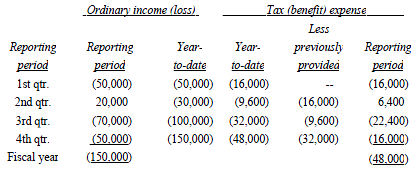
Note that both the income tax expense (2nd quarter) and benefit are computed using the estimated annual effective rate. This rate is applied to the year-to-date numbers just as in the previous examples, with any adjustment being made and realized in the current reporting period.
This treatment is appropriate because the accrual of tax benefits in the first, third, and fourth quarters is consistent with the effective rate estimated at the beginning of the year; in contrast to those circumstances in which a change in estimate is made in a quarter relating to the realizability of tax benefits not provided previously (or provided for only partially).
Example-2
In this case assume that Putra Corporation can carry back only $50,000 of the loss and that the remainder must be carried forward. Realization of income to offset the loss is not deemed to be probable. The estimated carryback of $50,000 would generate a tax refund of $12,000 (again assumed). The company is assumed to be in the 40% tax bracket (a flat rate is used to simplify the example).
The benefit of the operating loss carryforward is recognized only to the extent that it is deemed to be probable of realization. In this example, management has concluded that only one-fourth of the gross benefit will be realized in future years. Accordingly, only $10,000 of estimated tax benefit related to the carryforward of the projected loss is recordable.
Considered in conjunction with the carryback of $12,000, the company will obtain a $22,000 tax benefit relating to the projected current year loss, for an effective tax benefit rate of 14.7%. The calculation of the estimated annual effective rate is as follows:

Note: In the foregoing, the tax expense (benefit) is computed by multiplying the year-to-date income or loss by the estimated annual effective rate, and then subtracting the amount of tax liability or benefit provided in prior interim periods. It makes no difference if the current period indicates an income or a loss, assuming of course that the full-year estimated results are not being revised.
However, if the cumulative loss for the interim periods to date exceeds the projected loss for the full year on which the effective tax benefit rate had been based, no further tax benefits can be recorded, as illustrated above in the provision for the third quarter.
3. Operating Loss Occurring During An Interim Period
An instance may occur in which the company expects net income for the year and incurs a net loss during one of the reporting periods. In this situation, the estimated annual effective rate, which was calculated based on the expected net income figure, is applied to the year-to-date income or loss to arrive at a total year-to-date tax provision.
The amount previously provided is subtracted from the year-to-date figure to arrive at the provision for the current reporting period. If the current period operations resulted in a loss, the tax provision for the period will reflect a tax benefit.
Tax Provision Applicable to Discontinuing Operations Occurring in Interim Periods
Discontinuing operations are to be shown net of the related tax effects. The interim treatment accorded discontinuing operations does not differ from the fiscal year-end reporting required by GAAP. However, common practice is not to include these items in computation of the estimated annual tax rate. These items are generally recognized in the interim period in which they occur; that is, they are not annualized.
Recognition of the tax effects of a loss due to any of the aforementioned situations would be made if the benefits are expected to be realized during the year or if they will be recognizable as a deferred tax asset at year-end under the provisions of IAS 12.
If a situation arises where realization is not probable in the period of occurrence but becomes assured in a subsequent period in the same fiscal year, the previously unrecognized tax benefit should be reported in income until it reduces the tax provision to zero, with any excess reported in other categories of income (e.g., discontinuing operations) that provided a means of realization for the tax benefit.
If the decision to dispose of operations occurs in any interim period other than the first period, the income (loss) applicable to the discontinuing segment has already been used in computing the estimated annual effective tax rate. Therefore, a recomputation of the total tax is not required.
However, the total tax is to be divided into two components:
- That tax applicable to income (loss) before discontinuing operations
- That tax applicable to the income (loss) from the discontinuing segment
This division is accomplished as follows: A revised estimated annual effective rate is calculated for the income (loss) before discontinuing operations. This recomputation is then applied to the income (loss) from the preceding periods. The total tax applicable to the discontinuing segment is then composed of the difference between the total tax originally computed and the tax recomputed on remaining income before discontinuing operations.
Case Example
WorksWealthWisely Corporation anticipates net income of $150,000 during the fiscal year. The net permanent differences for the year will be $10,000. The company also anticipates tax credits of $10,000 during the fiscal year. For purposes of this example, we assume a flat statutory rate of 50%. The estimated annual effective rate is then calculated as follows:
Estimated pretax income = $150,000
Net permanent differences = (10,000)
Taxable income = 140,000
Statutory rate x 50%
Tax = 70,000
Anticipated credits = (10,000)
Total estimated tax = $ 60,000
Estimated effective rate
($60,000 / $150,000) = 40%
The first two quarters of operations were as follows:

In the third quarter, WorksWealthWisely made the decision to dispose of Division X. During the third quarter, the company earned a total of $60,000. The company expects the disposal to result in a onetime charge to income of $50,000 and estimates that losses subsequent to the disposal will be $25,000. The company estimates revised income in the fourth quarter to be $35,000.
The two components of pretax accounting income (discontinuing operations and revised income before discontinuing operations) are shown below:
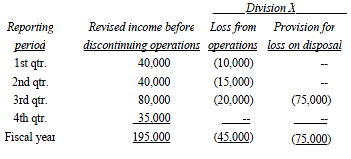
WorksWealthWisely must now recompute the estimated annual tax rate. Assume that all the permanent differences are related to the revised continuing operations. However, $3,300 of the tax credits were applicable to machinery used in Division X. Because of the discontinuance of operations, the credit on this machinery would not be allowed. Any recapture of prior period credits must be used as a reduction in the tax benefit from either operations or the loss on disposal.
Assume that the company must recapture $2,000 of investment tax credit which is related to Division X. The recomputed estimated annual rate for continuing operations is as follows:
Estimated (revised) ordinary income = $195,000
Less net permanent-
differences (10,000) = 185,000
Tax at statutory rate of 50% = $ 92,500
Less anticipated credits from-
continuing operations = (6,700)
Tax provision = $ 85,800
Estimated annual effective-
tax rate ($85,800 / $195,000) = 44%
The next step is then to apply the revised rate to the quarterly income from continuing operations as illustrated below:
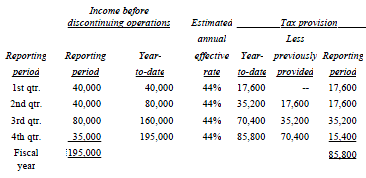
The tax benefit applicable to the operating loss from discontinuing operations and the loss from the disposal must now be calculated. The first two quarters are calculated on a differential basis as shown below:
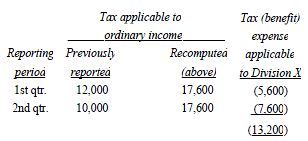
The only calculation remaining applies to the third quarter tax benefit pertaining to the operating loss and the loss on disposal of the discontinuing segment. The calculation of this amount is made based on the revised estimate of annual ordinary income, both including and excluding the effects of the Division X losses. This is shown below.

Source:
http://accounting-financial-tax.com/2010/10/accounting-for-income-taxes-in-interim-periods-ifrs-gaap/
No comments:
Post a Comment
Note: Only a member of this blog may post a comment.